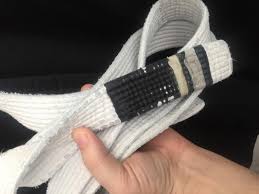The first day of any jiu-jitsu practitioner’s journey is always the most important. The moment any grappler decides to step on the mat signifies the beginning of a new lifestyle.
Many people start training jiu-jitsu for different reasons, and the allure of an academy takes many shapes. Some are interested in losing weight or learning a little self-defense. Others want to break up the monotony of their standard workout routine with something new.
An even smaller section starts training with big dreams of becoming a UFC champion or conquering the jiu-jitsu competition scene until the eventual conclusion of the difficulty of that endeavor becomes clear.
The reason why a new white belt decides to join a gym is unimportant, just as long they get on the mat. Because it won’t take long for them to realize that whatever reasons they thought they started to train were just an excuse to take that first step.
Jiu-jitsu will change you. There will be several secondary transformations during the process, but the art is more satisfying and life-altering than just losing weight or learning how to fight. It challenges players in unimaginable ways, and it won’t be an easy path.
Starting as a new white belt usually goes in one of two ways. Both end in suffering. There are the former athletes or “alpha” beginners that want to prove they are special, and there are the less confident beginners just holding on in class long enough to make it through the session.
The athlete will be ahead of the game in the beginning. Sheer agility and strength will guide them with most adversaries as they muscle their way through the first six months. But the less athletically inclined newbie will have a different struggle. Survival will be their primary function during the early stages, and learning techniques will be their only mantra as they manage the mats’ shark-infested waters.
The less athletic white belt will soon realize that focusing on techniques alone will only get them so far. Drilling against a non-resisting partner, while beneficial to developing muscle memory, does little to train the brain in the essential elements of learning the art. They need to learn how to win first.
There is no time to think about where you are and the quantum mechanics of each movement during a rolling session. So, it is often too late to react when a young grappler conceptualizes these advanced thoughts. Young white belts tend to get so caught up in deciphering the advanced computations of jiu-jitsu’s techniques that they forget the most crucial part. Stay alive.
Learning to execute even the fundamentals in a live rolling session takes years of practice. So, it is only natural to be discouraged by the confusion of remembering precise details your instructor explained earlier in class. Instead, I tell white belts feeling lost and a step behind to focus on broad strokes.
Most modern jiu-jitsu gyms use some form of intro curriculum to acclimate new students into training. They are designed so new white belts learn a few techniques from each position. Higher-level practitioners usually consider them basics. But the moves themselves are often inconsequential. The real lesson from a beginner class is learning BJJ rules from each position.
Jiu-jitsu is a martial art first. But, in that art, there is the game of BJJ, and all games have rules. Grapplers learn to play the game of jiu-jitsu to get better at the martial art of jiu-jitsu because it is a safe way to recreate the duress of a real-life confrontation daily. This environment is why jiu-jitsu is the most complete martial art for self-defense in our modern world.
Without the benefit of an athletic background, young white belts haven’t learned to compete in the combative elements that playing sports instills in more athletically inclined beginners. Knowing each position’s rules and focusing on their essential engagement strategies will teach them how to win.
In other words, if you are in someone’s closed guard, don’t focus on the eight-step sequence you learned two weeks ago. Instead, understand your primary goal is not to get swept or submitted, then just get past your opponent’s legs and hold on for dear life. Simplification is the key for white belts to gain confidence in their new world of real-time combat. The techniques will materialize on their own over time.
The “alpha” new white belt faces an entirely different set of obstacles to overcome. Most of these beginners are bigger, stronger, and typically have substantial athletic backgrounds. These superior attributes allow them to be more dominant in the early stages, so teaching them a winning mindset is unnecessary. Unlike their less inclined counterparts, years of development hardwired their minds to decipher the rules of engagement on a subconscious level.
But, where the first few weeks of training will be like returning to a lost lover, a more athletic white belt will realize in time that they can dominate the intro class newbies with their old rugby skill set. But competing with more experienced grapplers will require them to dial back their full-throttle assaults and learn to do things correctly.
Every day white belts join gyms and fall into one of these groups, and growing as a grappler requires a self-reflective transition from both. Our art forces weaker, less confident white belts to find the will to survive, but it humbles stronger white belts into accepting defeat as an essential element of their growth. There are not many activities that can challenge individuals in a manner genuinely specific to their needs.
So, hang in there, white belt. The first year is a maddening drive down a winding mountain road with failing breaks. But if you give it time, you’ll soon find out jiu-jitsu is precisely what your life is missing.










